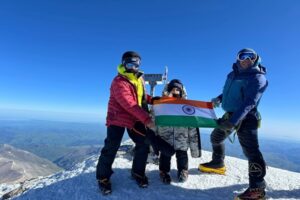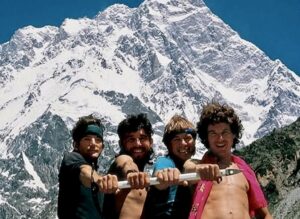There’s a precious moment about halfway through the 1991 documentary “Everest: Climb for Hope” — though it wouldn’t have felt that way 30 years ago.
After schlepping a 120-kilo box of communications equipment from Canada to Everest Base Camp, the climbing team marvels over the ability to make calls back home.
“It’s nothing short of miraculous,” narrator Leslie Nielson says.
That wouldn’t have sounded ironic three decades ago, but therein lies the charm of revisiting this relic of a bygone era. It shows just how much mountaineering has changed — from the food and equipment to the technology and attitudes.
This 40-minute documentary aired six years before Jon Krakauer published Into Thin Air, a chronicle of one of Everest’s worst disasters that also explained the capitalist philosophy transforming the mountain.
As a result, there’s a genuine sense of majesty and mystery suffusing this slightly older film. It starts with the protracted difficulty of traveling in the Himalaya and ends with the group’s failure to reach the summit via the North Col.
It’s a welcome change from modern times when Everest news is dominated by stories of trash heaps and Disneyland-style waiting lines.
“I guess we built it up from a $5 round of drinks to a million-dollar operation,” expedition leader Peter Austen said.
Yep. Times have changed.

Advanced Base Camp on the Mallory North Col route. Their team was the only one on the route that season. Photo: Pat Morrow
A time before commercial climbing
Canadian photographer and videographer Pat Morrow helped film the 1991 expedition. What he remembers most is the camaraderie. Everyone worked together, he said, which is what makes for adventure and unforgettable memories.
“In that era, you had to know how to climb,” Morrow said. “You were a team member, not a client paid to be babysat on a big hill.”

Morrow at work on the film. Photo: Pat Morrow
From Morrow’s perspective, the high mountains have changed for the worse. He worked as an adventure photographer for 35 years, believing that his images and stories would result in greater respect for the environment and local culture.
In his opinion, the exact opposite has happened.
“Even now, people go into the base camps bringing COVID,” he said. “Westerners get flown out, but the locals don’t get medical help…The sheer numbers of tourists going into these hitherto hard-to-reach places, wherever they are — the local cultures are being overwhelmed. There’s no positive aspect that I can see.”
But this 1991 film harkens back to a time before all that.

A quiet Everest Base Camp. Photo: Pat Morrow
Raising awareness
After a few shots of Everest in the distance, the documentary begins with the human story behind the expedition: a Toronto father caring for a daughter with Rett Syndrome.
According to the documentary, Ernie Sniedzins formed the expedition to raise money and awareness of this rare genetic disorder. Even today, research has revealed few facts about Rett Syndrome. So the “Climb for Hope” expedition brought together a group of climbers to bring attention to the struggle of Sniedzins’ daughter and people like her.
“The ‘Climb For Hope’ was the first time Mount Everest had been attempted for charitable purposes, and the climb did a great deal to raise awareness of the Rett Syndrome in Canada,” team leader Peter Austen wrote on his website.
Unfortunately, the documentary doesn’t do much to justify that sentiment. It doesn’t actually explain much about Rett Syndrome. Or how much money they raised. Or where that money went. Or how exactly the expedition raised awareness of the disease.
When climbing leader Ross Cloutier brings it up later, it feels almost obligatory.
“So remember, the climb is for Rett,” Cloutier said. “The climb is to raise funds for them and exposure for them. It’s not to leave bodies on the hillside.”

The North Col of Everest. Photo: Pat Morrow
9,000 pre-packaged meals
Watching this crew prepare for their Everest expedition is one of the few moments when we can feel grateful for the rise of highly organized — if expensive — expedition companies.
The crew painstakingly puts together 9,000 pre-packaged meals. A woman at a sewing machine makes “specialized clothing” for the climbers. A cameraman makes some DIY protection for his film camera.
Before long (in screen time, anyway) the crew sets off on the long journey to Everest Base Camp. In total, the group includes 10 climbers, five support staff, nine family and friends, a film crew of four, and five Sherpas.
With shots of prayer wheels accompanied by 1990s sound effects, their journey through Tibet offers some of the film’s best moments.
But getting to the mountain through China-controlled Tibet is no picnic. The buses get stuck in the mud from massive landslides, requiring climbers to help locals stack rocks on the wet road. Eventually, they have to leave the vehicles behind and trek on foot.
In one of the best sequences, a “nine-time all-American gymnast” tries carrying the aforementioned box of communications equipment. He manages to get 10 metres before giving up. Three porters then carry it over seven kilometres in three hours.

Lhakpa Tshering cleans up in a poker game with John McIsaac and Tim Rippel, Advance Base Camp, Everest North Col route. Photo: Pat Morrow
Refreshing failure
Perhaps it’s the glut of new outdoor documentaries arriving every week, but it’s refreshing to watch a team fail.
That’s what happens to the crew as they face injuries and bad weather in their attempt to scale Everest’s North Col route.
“For every two climbers to make the summit on this route, one has died,” Leslie Nielsen tells us soberly.
Unfortunately for the Canadians, luck was not on their side. Jet-stream winds arrive earlier than expected, plunging temperatures to -40˚ and generating winds over 160kph. Camp Five — crucial for their final summit attempt — gets blown off the mountain before they arrive.
Exhausted and defeated, they head back to safety.
“They are shells of men now,” Nielsen says. “Very little left inside them. With the bright light of challenge ahead extinguished, the gloom of failure fills the narrow world they perceive.”
Upon returning to safety in Base Camp, the climbers try to connect their failure to the reality of Rett Syndrome, with clumsy results.
Ultimately, this old-school documentary won the gold medal for Best Information/Documentary at the New York International Film Festival. Judging it by today’s standards, the film offers a much-needed perspective on how far mountaineering has come — for better and for worse.






